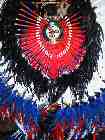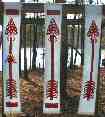|
American
Indian Affairs (AIA)
North Carolina's State - Recognized Tribes
Coharie
The
Coharie people are descendants of the Neusiok Indians. Since
the 1970's the tribe has lived along the Little Coharie
River in Sampson and Harnett Counties. In the 1800's the
Coharie established schools with their own teachers and
funds. In 1943 Coharie tribe started a high school. The
tribe's center of activity is the church.
Eastern
Band of Cherokee
In 1838
the United States government made the Cherokee people leave
their homelands. The forced march of the Cherokee to Oklahoma
became known as the Trail of Tears. A small group of Cherokee
who were allowed to remain in the North Carolina mountains
became the Eastern Band of Cherokee. The Qualla Boundary
reservation, where much of the tribe now lives, was chartered
in 1889.
Haliwa-Saponi
The
Haliwa-Saponi people are descendants of the Saponi, Tuscarora,
Occaneechi, Tutelo, and Nansemond Indians. In the 1700's
these five tribes merged, settling in the area of Halifax
and Warren Counties where the Haliwa-Saponi live today.
In 1957 the Haliwa-Saponi established the only tribal school
recognized by North Carolina at that time. Today, the school
building houses the Haliwa-Saponi Tribal Charter School.
Lumbee
The
Lumbee is the largest tribe east of the Mississippi River
and the ninth-largest tribe in the country. They descended
from the Cheraw and related Siouan-speaking groups. The
name Lumbee, adopted in 1952 was derived from the Lumber
River, which flows through Robeson County. The tribe lives
in Robeson, Hoke, Scotland, and Cumberland Counties, where
it has a strong presence in local government and the community.
Meherrin
Written
history of the Meherrin, which means "people of the
muddy water," dates back to 1650. Tribal enemies and
conflicts with colonists forced them form Virginia to Hertford
County. Today, the tribe also lives in Bertie and Gates
Counties. Meherrin tribal members have renewed interest
in their traditional arts, crafts, and culture.
Occaneechi-Saponi
The
Occaneechi community is descended from the Saponi and related
Indians who occupied the Piedmont of North Carolina and
Virginia the in Pre-contact period. Under the 1713 treaty
with the Colony of Virginia, the communities of Saponi,
Occaneechi, Eno, Tutelo, and Cheraw, among others, agreed
to form a confederation. Today, the tribe lives primarily
in Alamnace and Orange Counties.
Sappony
From
more than two centuries, the Sappony have lived in the central
Piedmont straddling the North Carolina and Virginia border.
They descended from a band of the Saponi Indian nation that
stayed behind when the tribe moved north and joined the
Iroquois in 1753. The tribe established a church in the
1830's and a school in 1888. Today, tribal members are documenting
their past and revitalizing their community.
Waccamaw-Siouan
The
first written record of the Waccmaw-Siouan people appeared
in 1712. The tribe, then known as the Woccon, lived near
Charleston, South Carolina. After fighting a war with South
Carolina, the Waccamaw-Siouan retreated to the swampland
of North Carolina. Today, the tribe lives near Lake Waccamaw,
in Columbus and Bladen Counties.
|








